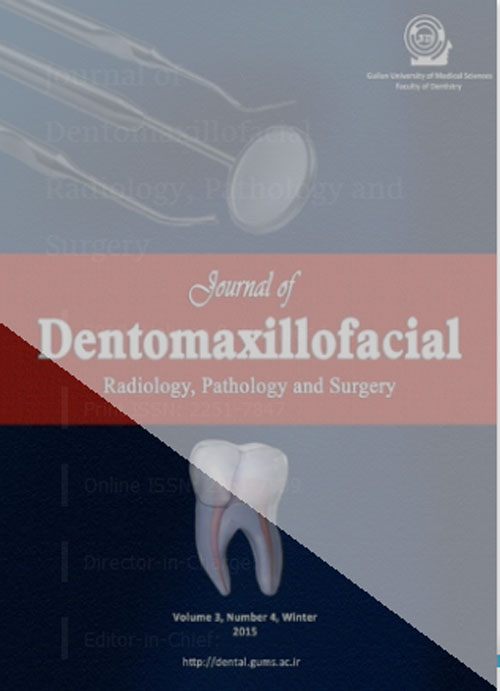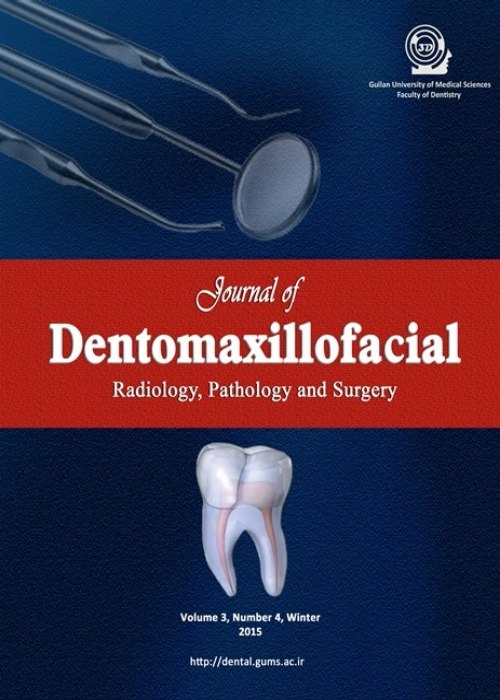فهرست مطالب

Journal of Dentomaxillofacil Radiology, Pathology and Surgery
Volume:7 Issue: 4, Winter 2018
- تاریخ انتشار: 1397/10/19
- تعداد عناوین: 7
-
-
Pages 137-144Introduction
Halitosis (bad breath) is one of the common causes of referral to dental clinics. Dentists require adequate knowledge and good practice to evaluate and manage halitosis. The present study aimed to assess the knowledge and practice of dental students in Guilan University of Medical Sciences on halitosis.
Materials and MethodsA simple randomized, cross-sectional, questionnaire-based study on the knowledge and practice of dental students about halitosis in dental faculty of Guilan University of Medical Science (GUMS) was conducted. 140 subjects were selected using stratified random sampling technique. students belonging to dental faculty of GUMS were Included and subjects unwilling for the study were excluded. The collected data were analyzed in SPSS V. 20 by Chi-squared, Analysis of Variance (ANOVA), t-test, and regression analysis.
ResultsMean age of subjects were 23.5 years. 53.6% subject had moderate knowledge about halitosis. The results revealed that the fifth and sixth year students had more information than the third and fourth year students (P<0.0001). Comparing the performance of female and male students indicated a better hygiene status in females. Based on Chi-squared test results, the frequency of using mouthwash was significant in terms of the academic year (P=0.049).
ConclusionThe mean knowledge score of students about halitosis was moderate. knowledge score and oral hygiene status had no significant relationship with marital status. Despite females having a significant better oral hygiene compared to males, the knowledge score about halitosis had no relation with gender. Students with higher academic grades, had significantly higher knowledge score about halitosis and maintained a significant better oral hygiene by using Chlorhexidine (CHX) mouth wash more frequently.
Keywords: Awareness, Halitosis, Dental students -
Pages 145-150Introduction
The topography of the sinus floor and its relationship with maxillary teeth roots vary with age, pneumatization size and grade, positioning of the teeth, and genetics.
ObjectivesThis study used Cone-Beam Computed Tomography (CBCT) to evaluate the distance between posterior teeth and the maxillary sinus floor in patients of Rafsanjan, Iran.
Materials and MethodsThis descriptive cross-sectional study evaluated 35 CBCT radiographs of patients over 20 years old, who were referred to a private oral and maxillofacial radiology clinic in Rafsanjan for dentistry procedures. CBCT imaging was performed. After obtaining Multi-Planar Reformatted (MPR) images, a maxillofacial radiologist measured the vertical relationships between all roots of posterior maxillary teeth and the maxillary sinus floor and classified them as described by Didilescu et al. The collected data were analyzed by SPSS V. 21.
ResultsGenerally, the distobuccal root of the second molars had the shortest distance from the maxillary sinus floor. The statistical tests showed no significant relationships among the measured distances and age, gender, or the assessed region.
ConclusionSince the distance between posterior maxillary teeth and maxillary sinus floor was mostly type 0 in the population of Rafsanjan, clinicians are recommended to use CBCT to obtain adequate knowledge of anatomy and morphological details of tooth roots before any treatment, especially surgical procedures.
Keywords: CBCT, Maxillary sinus, Posterior teeth -
Pages 151-156Introduction
Using fluoridated toothpaste is the most feasible and common form of applying fluoride. Fluoride absorption could increase tooth microhardness. Therefore, the present study aimed to investigate the changes of primary tooth enamel microhardness following KAM, BATH, and CREST pediatric toothpaste use.
Materials and MethodsIn total, 45 healthy primary molar teeth were randomly divided into three 15-membered groups. The microhardness of samples was measured before the test (step 1). Each sample was immersed into 5mL of 1% stirred citric acid; then, in 10 mL of 1%, unstirred citric acid for 15 minutes, and microhardness was re-measured (step 2). Then, the samples were immersed in the suspension of three different toothpaste types (5 g toothpaste +10 mL artificial saliva). Microhardness was re-measured 10 days later (step 3). Analysis of Variance (ANOVA) and Tukey test were applied for statistical analysis.
ResultsDemineralization decreased the surface microhardness of enamel (P=0.001). Moreover, the surface microhardness recovery was significant in all groups (P=0.001). The greatest recovery in microhardness after the treatment with toothpastes belonged to KAM toothpaste; however, there were no significant differences between surface microhardness produced by the three toothpastes.
ConclusionThere was no significant difference in microhardness changes after applying KAM (MFP, 200 ppm), BATH (MFP, 132 ppm) and CREST (NaF, 500 ppm) toothpastes. Thus, the use of Iranian pediatric toothpastes, which are inexpensive and have lower concentration of fluoride, are recommended.
Keywords: Fluorides, Hardness, Dental Enamel, Toothpastes -
Pages 157-162Introduction
Calculating the correct vertical relation between mandible and maxilla is considered to be a crucial element in successful placement of removable and fixed partial dentures.
Materials and MethodsThis is an analytical study with cross-sectional conducted in 2018 on 128 patients to determine the correlation between FreeWay Space (FWS) and gonial angle. For measuring the correlation between them, their Vertical Dimension at Rest (VDR), Vertical Dimension of Occlusion (VDO), and Maximum Intercuspation Position (ICP) were recorded. The difference between VDR and VDO was reported as FWS. For measuring gonial angle, panoramic radiography method was used and data were analyzed using independent t-test and Pearson correlation test at a significance level of P<0.05.
ResultsThe correlation coefficient between FWS and gonial angle, between FWS and age, and between gonial angle and age were reported as r=-0.052, 0.137, and -0.102, respectively. Furthermore, the significance level for the difference in FWS and gonial angle between men and women was found to be p=0.267 and p=0.6, respectively.
ConclusionThere was no significant relationship between FWS and gonial angle. Hence, gonial angle cannot be used for measuring the FWS.
Keywords: Freeway Space, Vertical Dimension At Rest, Vertical Dimension of Occlusion -
Pages 163-166Introduction
The most prevalent approach for the obturation of roots, which are treated endodontically, is lateral condensation. Finger spreaders insignificantly affect packing the gutta-percha cones. This survey aimed to compare the compaction index of root canal obturation obtained with Stainless Steel (SS) and Nickel-Titanium (Ni-Ti) spreaders and different gutta-percha tapers.
Materials and MethodsForty extracted maxillary central incisors were randomly divided into 4 groups of 10 teeth. In group 1, the canals were filled with 0.02 tapered gutta-percha and SS spreader; group 2 with 0.02 tapered gutta-percha and Ni-Ti spreader; group 3, with 0.04 tapered gutta-percha and SS spreader, and group 4 with 0.04 tapered gutta-percha and Ni-Ti spreader. The compaction index was compared among the different groups using the Independent Samples t-test.
ResultsThe mean compaction index for the groups that were filled with 0.02 tapered gutta-percha cones was 1.44 with the use of SS spreaders and 1.18 with the use of Ni-Ti spreader; however, the difference was not statistically significant. Furthermore, the mean compaction index for the groups that were obturated with 0.04 tapered gutta-percha cones was 1.561 with the use of SS spreaders and 1.269 with the use of Ni-Ti spreaders. Similarly, this difference was not statistically significant.
ConclusionThe obturation compaction index was higher when using SS spreaders and 0.04 tapered gutta-percha cones; however, the differences were not statistically significant.
Keywords: Gutta-Percha, Stainless Steel, titanium nickelide, Nickel Titanium, Root canal obturation -
Pages 167-172Introduction
Becoming completely edentulous is a major concern of dentists and other health care providers. It mostly targets aged population and has numerous comorbidities. An old-fashion but currently used treatment plan for edentulism is the complete denture method. In this study, we aimed to investigate the time when older people in Iran are in need of complete dentures and the reasons for tooth loss in this country.
Materials and MethodsThe medical records of 200 patients were collected from Shahid Heidari dental clinic for the study. Patients were completely edentulous and treated with complete dentures for the first time. Their systemic disease, periodontitis and smoking status were analyzed at a significance level of P<0.05.
ResultsThe Mean±SD age for becoming edentulous was 52.1±1.07 years. Most populated age group was 45-50 and 55-60 years. Systemic disease and periodontitis was reported more in younger patients, while most of those who smoke aged more than 52 years.
ConclusionIt can be concluded that the mean age of becoming edentulous in Iran is significantly lower than in other countries and more studies are required to assess the current status of edentulism in Iran. There is also a need for implementing an enhanced dental care plan for Iranian elderly population.
Keywords: Smoking, Periodontitis, Dental Clinics, Mouth, Edentulous Denture, Complete -
Pages 173-182Introduction
Compared to conventional composites, bulk-fill composites increase polymerization depth and contraction stress, and reduce cuspal deflection. Therefore, it is claimed that their microleakage is reduced. This study aimed to compare the microleakage of bulk-fill composites (flowable and packable) with conventional light-cured ones.
Materials and MethodsThis in vitro experimental study was done on 60 human extracted premolars. We made standard Class II cavities (4 mm in height, 3 mm in length buccolingually, and 1.5 mm in axial depth) in the teeth. The teeth were randomly divided into three groups based on the type of composite: group I consists of packable bulk-fill (x-tra fill packable; VOCO Company) composite, group II with flowable bulk-fill (x-tra base; VOCO Company), and group III with conventional composite (Grandio; VOCO Company). The total-etch bonding system (the 5th generation) was applied in all cavities. After restoration, the teeth were thermocycled. Finally, the microleakage rate was evaluated using a stereomicroscope. The data were analyzed using the Chi-square test (α=0.05) in SPSS.
ResultsThe results indicated no statistically significant difference between enamel and dentinal margins in bulk-fill packable and conventional composites (P=0.06). In the bulk-fill flowable group, dentinal margins had greater dye penetration to the enamel margin in the axial surface (P<0.05). There was no significant difference between the three groups in terms of marginal microleakage of enamel and dentin (P<0.05).
ConclusionUsing bulk-fill flowable composites on the dentinal cavity is not suitable with the thickness recommended by the manufacturer. To prove these results, we need to design and perform long-term in vitro and in vivo studies. The use of the incremental technique for placement of composites, even with the bulk-fill group sounds to be more logical.
Keywords: Bulk-fill composite, Microleakage, Composite


